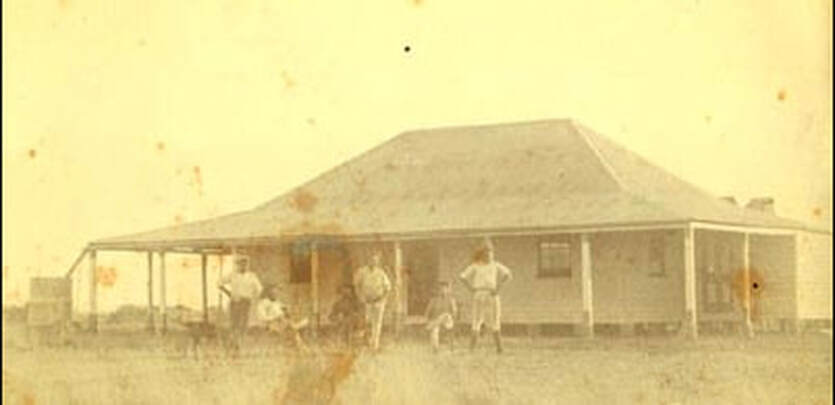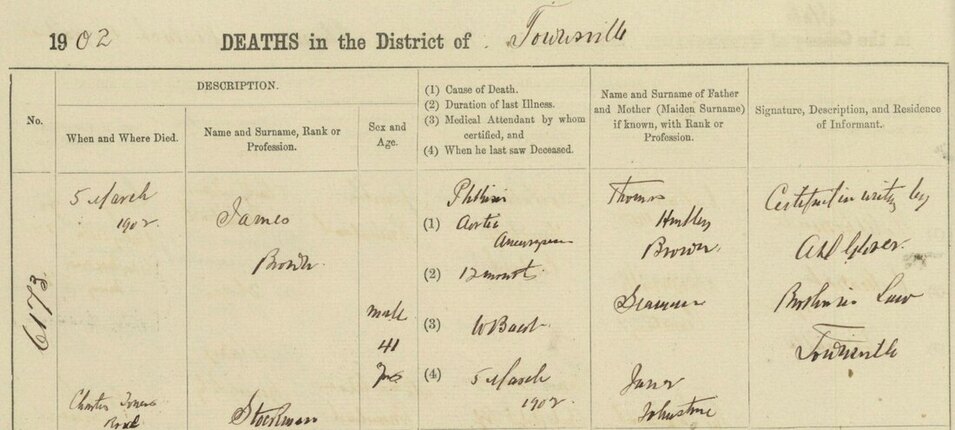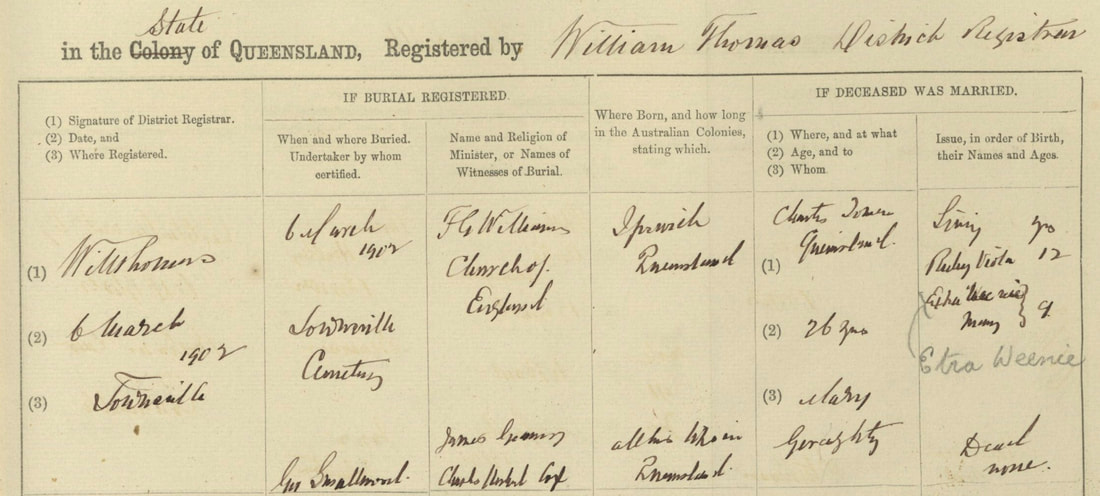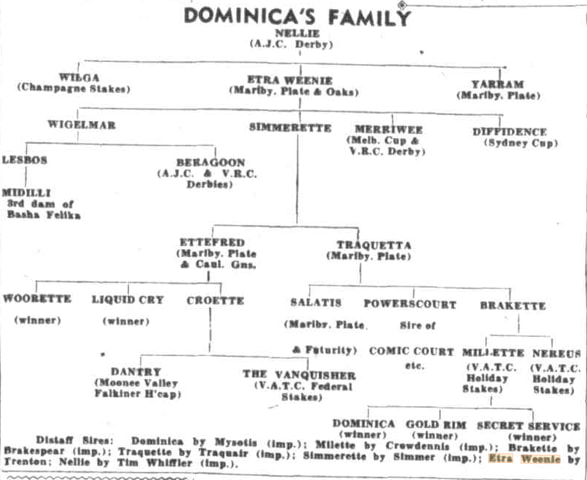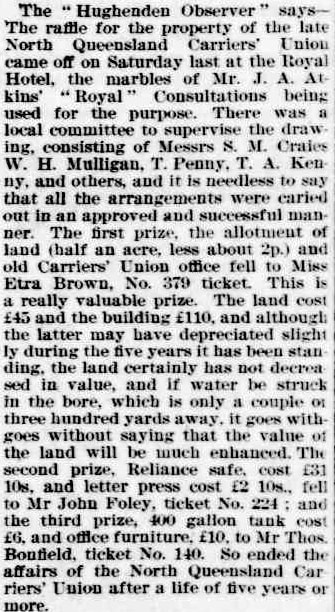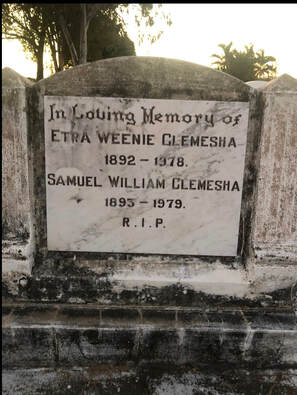James Brown b. 1862 d 1902
Hughenden, Horses, High Society
A year and a day after the death of their previous child, John, the Browns announced the birth of their next son:
25 Feb 1862 Queensland Times
Birth - at Ipswich on the 18th instant, Mrs Brown of Fernie Lawn, of a son.
In 1876 when his father passed away, James was 14, and 18 when Jane married Lewis Eversden. He may have commenced work as a farm hand or a horse handler before 1876 and a move to Tartha with his mother is unlikely. Around the time the Glovers arrived in Townsville, James would have been working as a stockman and later as a horse trainer at Afton Downs, Hughenden, owned by the very well-connected Charles Norman Armatage. Armatage was a breeder of horses and race horses and founding president in 1884 of the Hughenden Jockey Club. When he married in 1890, Armytage was described as "of Afton Downs and "Como", Toorak".
James was described as a "bushman" on daughter Ruby's birth certificate in 1889, but by 1892 and the birth of his second daughter, Etra Weenie, he claimed to be a "horse trainer."
Marriage
In 1888 James Brown married Mary Geraghty in Charters Towers. Mary was born in County Westmeath, Ireland. They had 2 children:
Ruby Viola Brown b. 1889 d. 1974
Ruby was born at Hughenden - only 3 years after the first recorded birth in the area. She married Francis Amos Beazley, a horse trader, in 1911. Frank's father consolidated his fortune trading horses during the Russo-Japanese War 1904 - 1905. Frank profited similarly during World War 1. Over the years, the Beazleys shared their time between western Queensland, Rockhampton and Vaucluse, Sydney. Frank was a prominent racehorse owner, often described in newspapers as "a sportsman". They had 2 daughters who became well-known socialites in both Sydney and London. At the time, both would have been described in daily papers as "well-known frockers". Frank and Ruby spared no expense on travel between their various homes, their interests, their daughters' social aspirations, and entertaining. Ruby passed away in 1974, having outlived her "sportsman" husband by 30 years. Ruby and Frank's daughters both married, one into the Moses family which is connected to the famously wealthy horse breeders, John and Denise Cobcroft.
Etra Weenie Brown b. 1892 d. 1978
Etra Weenie (perhaps also known as "May", sometimes as "Mary") was born at Hughenden too. She became a nurse and in 1921 married grazier Samuel (William) Clemesha, son of a prominent grazier and onetime hotelier, Samuel Clemesha from Aramac. They had 3 children, 2 daughters (1 died when only 20 months of age) and a son. William was a prominent grazier (and lawn bowler) in the Hughenden area and their descendants live in Queensland today.
Death
James passed away at a relatively young age in Townsville, suffering from heart disease and tuberculosis. His death was certified by his brother-in-law, Andrew Glover, his occupation recorded as "stockman". His widow Mary married William Wilson in 1910 and died in 1933.
The Legacy of James Brown
Luck is his legacy. He rode his luck and profited. Despite his early death, James's 2 daughters married very well and lived long lives. Ruby's rise to the very heights of Sydney society would have warmed her grandmother's heart.
A year and a day after the death of their previous child, John, the Browns announced the birth of their next son:
25 Feb 1862 Queensland Times
Birth - at Ipswich on the 18th instant, Mrs Brown of Fernie Lawn, of a son.
In 1876 when his father passed away, James was 14, and 18 when Jane married Lewis Eversden. He may have commenced work as a farm hand or a horse handler before 1876 and a move to Tartha with his mother is unlikely. Around the time the Glovers arrived in Townsville, James would have been working as a stockman and later as a horse trainer at Afton Downs, Hughenden, owned by the very well-connected Charles Norman Armatage. Armatage was a breeder of horses and race horses and founding president in 1884 of the Hughenden Jockey Club. When he married in 1890, Armytage was described as "of Afton Downs and "Como", Toorak".
James was described as a "bushman" on daughter Ruby's birth certificate in 1889, but by 1892 and the birth of his second daughter, Etra Weenie, he claimed to be a "horse trainer."
Marriage
In 1888 James Brown married Mary Geraghty in Charters Towers. Mary was born in County Westmeath, Ireland. They had 2 children:
Ruby Viola Brown b. 1889 d. 1974
Ruby was born at Hughenden - only 3 years after the first recorded birth in the area. She married Francis Amos Beazley, a horse trader, in 1911. Frank's father consolidated his fortune trading horses during the Russo-Japanese War 1904 - 1905. Frank profited similarly during World War 1. Over the years, the Beazleys shared their time between western Queensland, Rockhampton and Vaucluse, Sydney. Frank was a prominent racehorse owner, often described in newspapers as "a sportsman". They had 2 daughters who became well-known socialites in both Sydney and London. At the time, both would have been described in daily papers as "well-known frockers". Frank and Ruby spared no expense on travel between their various homes, their interests, their daughters' social aspirations, and entertaining. Ruby passed away in 1974, having outlived her "sportsman" husband by 30 years. Ruby and Frank's daughters both married, one into the Moses family which is connected to the famously wealthy horse breeders, John and Denise Cobcroft.
Etra Weenie Brown b. 1892 d. 1978
Etra Weenie (perhaps also known as "May", sometimes as "Mary") was born at Hughenden too. She became a nurse and in 1921 married grazier Samuel (William) Clemesha, son of a prominent grazier and onetime hotelier, Samuel Clemesha from Aramac. They had 3 children, 2 daughters (1 died when only 20 months of age) and a son. William was a prominent grazier (and lawn bowler) in the Hughenden area and their descendants live in Queensland today.
Death
James passed away at a relatively young age in Townsville, suffering from heart disease and tuberculosis. His death was certified by his brother-in-law, Andrew Glover, his occupation recorded as "stockman". His widow Mary married William Wilson in 1910 and died in 1933.
The Legacy of James Brown
Luck is his legacy. He rode his luck and profited. Despite his early death, James's 2 daughters married very well and lived long lives. Ruby's rise to the very heights of Sydney society would have warmed her grandmother's heart.
1902 James Brown Death Certificate
Comments
Birth
Jane had learnt a powerful lesson from the death of infant John: Fernie Lawn, remote from the Ipswich hospital and medical assistance, was not an ideal place to bring a child into the world. James was born in Ipswich.
Death
James had been an unwell man for at least 12 months when he passed away at his home on Charters Towers Rd - see certificate. His death was certified by Andy Glover - perhaps indicating a close bond, forged by their common interest in race horses.
Etra Weenie .... the racehorse .... the daughter .... the start of a lucky streak
Etra Weenie was a Victorian thoroughbred, owned by the legendary Herbert Power. The horse was appropriately named - "Etra weenie" means "go fast" in an Aboriginal language. As a 2 year old, she controversially won the November 1891 Maribyrnong Plate by 4 lengths with "ridiculous ease" after a "poor showing" at her first start a fortnight earlier at Caulfield. It was said after the win that an improved showing was anticipated by those well acquainted with her galloping abilities. By coincidence, the runner-up was a horse named ... The Captain. You wouldn't read about it!
Etra Weenie did not race again before Etra Weenie Brown was born on 1 May 1892. Some reasonable comments about the name chosen for James's second daughter would be:
Etra Weenie's second campaign began in October 1892. Strongly fancied in the betting, she finishing down the running. Next she started as the 10-1 rank outsider in a field of 5 (yes, only five runners) in the VRC Oaks and duly won at 10-1. Since 1920, one of the important races on the VRC calendar has been the Herbert Power Stakes, the main lead-in race to the Caulfield Cup, named in honour of Etra Weenie's owner. What does that say about the integrity of racing in the 1890s through to the 1920s?
Etra Weenie went on to become a celebrated broodmare and featured in many horse breeding articles for the next 60 years. Her son Merriwee won the 1899 Melbourne Cup and she was 3rd dam to the sire of that famous 1950 Melbourne Cup winner, Comic Court.
Birth
Jane had learnt a powerful lesson from the death of infant John: Fernie Lawn, remote from the Ipswich hospital and medical assistance, was not an ideal place to bring a child into the world. James was born in Ipswich.
Death
James had been an unwell man for at least 12 months when he passed away at his home on Charters Towers Rd - see certificate. His death was certified by Andy Glover - perhaps indicating a close bond, forged by their common interest in race horses.
Etra Weenie .... the racehorse .... the daughter .... the start of a lucky streak
Etra Weenie was a Victorian thoroughbred, owned by the legendary Herbert Power. The horse was appropriately named - "Etra weenie" means "go fast" in an Aboriginal language. As a 2 year old, she controversially won the November 1891 Maribyrnong Plate by 4 lengths with "ridiculous ease" after a "poor showing" at her first start a fortnight earlier at Caulfield. It was said after the win that an improved showing was anticipated by those well acquainted with her galloping abilities. By coincidence, the runner-up was a horse named ... The Captain. You wouldn't read about it!
Etra Weenie did not race again before Etra Weenie Brown was born on 1 May 1892. Some reasonable comments about the name chosen for James's second daughter would be:
- presuming James won a significant amount betting on the horse, the bet had to be the result of insider-information. There are 2 possible sources: his employer C.N. Armytage, or ... could it have been? ... "A Barber of Renown"? Though the former is more likely, it would be a wonderful story if the tip came from Andy Glover.
- hopefully, the unusual name choice was agreed upon in advance by James and Mary and was not the result of excessive celebration by James at the pub closest to the hospital.
- this delightful name is unique. James's death certificate has "Mary" added to her name, though Etra Weenie's birth certificate does not. Her headstone makes no mention of "Mary" or "May", names by which she may have been known.
Etra Weenie's second campaign began in October 1892. Strongly fancied in the betting, she finishing down the running. Next she started as the 10-1 rank outsider in a field of 5 (yes, only five runners) in the VRC Oaks and duly won at 10-1. Since 1920, one of the important races on the VRC calendar has been the Herbert Power Stakes, the main lead-in race to the Caulfield Cup, named in honour of Etra Weenie's owner. What does that say about the integrity of racing in the 1890s through to the 1920s?
Etra Weenie went on to become a celebrated broodmare and featured in many horse breeding articles for the next 60 years. Her son Merriwee won the 1899 Melbourne Cup and she was 3rd dam to the sire of that famous 1950 Melbourne Cup winner, Comic Court.
Aboriginal dictionary - the meaning of Etra Weenie
Etra Weenie - progeny - some very famous horses: Basha Felika and Comic Court
Lucky James Rolls the Etra Weenie dice again
James's luck did not end with the horse Etra Weenie. 'The 1895 "Hughenden Observer" records he purchased a raffle ticket in his 3 year old daughter's name, winning a property in Hughenden.
"Etra Weenie" had become James's ticket to fortune. There would have been at least 400 tickets in the raffle - so James landed another longshot by using the lucky name.
Imagine the celebration!
James's luck did not end with the horse Etra Weenie. 'The 1895 "Hughenden Observer" records he purchased a raffle ticket in his 3 year old daughter's name, winning a property in Hughenden.
"Etra Weenie" had become James's ticket to fortune. There would have been at least 400 tickets in the raffle - so James landed another longshot by using the lucky name.
Imagine the celebration!
